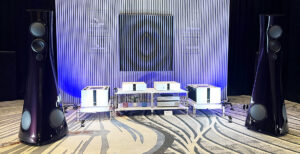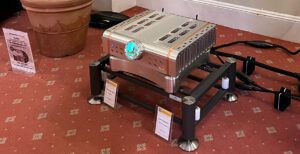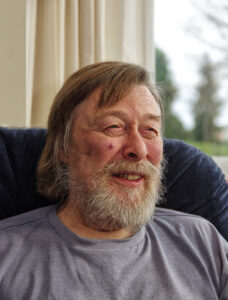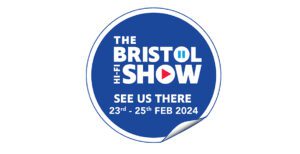
The TechDAS turntable system has quickly become one of the most important vinyl replay systems in today’s high-end. The Air Force One and now Air Force Two turntables are rated by many as the best turntables ever produced.
We were fortunate to be granted a brief interview with the CEO and designer of TechDAS, Hideaki Nishikawa at this year’s High End Show in Munich.
AS: Why do you think there has been a vinyl revival?
HN: Because we hear in analogue, and we hear that digital sound in the high frequencies and don’t like it. I have worked with digital technology for more than 25 years, but analogue technology is stronger for me. The signal to noise ratio of digital is better, but that’s the only thing I think where it is better.
That is why I have worked with air technology, because it can help improve the signal to noise ratio of turntables.
AS: Please tell us your background, before you began designing TechDAS? Have you always been involved with turntables?
HN: No. Originally I worked for Stax, as an engineer on electrostatic earspeakers. However, following that, I was employed by Micro-Seiki as chief designer and created many turntables for that brand. Then I met Mr. Nakanishi, and worked with him until he retired, at which time I took over his business as a high-end distributor.
AS: Why so long a gap between your Micro-Seiki designs and TechDAS?
HN: I imported and sold another turntable in Japan, and importantly this meant I had no time to devote to make something of quality. Now I am old enough to concentrate on my original vision; to make the best analogue turntable possible!
Also, for this product, I needed the best vacuum systems possible; air suspension, air bearing, air damping, and air suction. I have some considerable experience in this field from my time with Micro-Seiki and I felt this technology was not good enough. So, I waited for the technology to improve.
AS: What components in the air mechanism you use were the most important to the design?
HN: You are the first journalist to ask about this! The secret is compression! Compression is very important. We do not use a fish pump; instead we design our own version using a solenoid valve and using extremely small holes to make the compression very stable and finely tuned, which is absolutely vital to the TechDAS performance.
Everyone thinks it is just about creating a strong vacuum to hold down the record, but it is important to have a balance in all things. Even air. Good compression gives that good balance.
AS: But isn’t a vacuum important in clamping the LP?
HN: Yes, but what I learned is that the vacuum is not simply to hold the record on the platter. It also damps vibration. No-one else seems to recognise this, but that damping is an important part of why vacuum platters sound as they do. The disc cavity is very important, especially with a high-mass platter.
When I saw my prototype, I knew I was on the right track, because it helped with vibration. Vibration (whether from the record or external forces, even from tonearm and cartridge) is a huge problem. Cancelling these vibrations without air systems is not possible.
AS: Why do you also use an air condenser?
HN: We use it to help cancel ‘ripple’. Just like in the power supply of an amplifier. It helps take the ‘phut-phut-phut’ away from the pump. This is very important in sound quality.
AS: Tell us about the platter.
HN: The Air Force One has a 29kg platter of stainless steel, which is considered in both dynamic and static balance; most designs just take one of these important elements into consideration, and that comes at the expense of the other. This is important in helping to reduce wow and flutter, and is why our turntable is very speed stable.
AS: Sorry, I meant that you offer a choice of upper platter material. Why? What are the benefits of each?
HN: The TechDAS Air Force One offers a duralumin, stainless steel, or methacrylate platter. All three can incorporate the vacuum or not.
For me, stainless steel has the best low frequency performance and is like American turntables, where the methacrylate is brighter, like German players. I prefer duralumin, because it has the best dynamic range.
AS: Didn’t one of the Micro-Seiki players have a duralumin platter?
HN: [Long pause] Yes. SX-8000 II. That was my design! [Laughs]
AS: How can you bring this technology down to Air Force Two?
HN: We use oil damping instead of air damping and we use a solid cast aluminium platter, which brings the price down without sacrificing too much quality. Otherwise it’s almost all Air Force One!
The difference is low level. You can feel the air moving around the studio on One, while on Two you don’t feel that. But that’s all.

AS: What do you think is the secret to TechDAS’ ‘instant’ success in the high-end?
HN: Every turntable has its own character. For most companies, this is a good thing because people buy a turntable because it has it’s own character, and the bigger the turntable, the stronger that character becomes. I don’t want to do that. I just wanted quality. I started by trying to remove character from the Air Force One. And that continues to the Air Force Two.
I feel this ‘character’ in turntables comes from vibration, and the more you work on air technology, the less ‘character’ in the turntable.
AS: What’s next for TechDAS? Bigger or smaller?
HN: We already make two turntables and a cartridge. We don’t make an arm; not because it is difficult, but because I am already a distributor in Japan for Graham tonearms, and I honour and respect that relationship.
In time though, I will produce Air Force Zero. That will be my last design, because it will be the best turntable I know how to make. I can’t say much on this now, but it will have a far larger platter for better turning moments, as well as a bigger power supply, and because of the size, its own stand.
AS: Mr Nishikawa – thank you!
Our additional thanks to Katsuhiko Sumi for his work as translator during this interview
Tags: FEATURED
By Alan Sircom
More articles from this authorRead Next From Blog
See all
AXPONA 2024 Show Report Part One
- Apr 19, 2024

Audio Show Deluxe 2024: A photo show report
- Mar 28, 2024

Paul Messenger 1949-2024: A personal tribute
- Mar 26, 2024

Bristol Hi-Fi Show 2024: See You There!
- Feb 21, 2024











